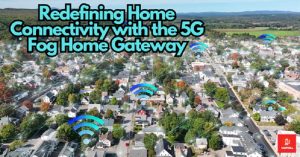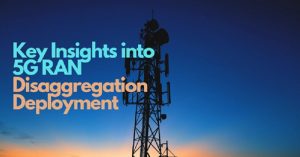Sönderdelning and Driftsättning with RF Drive Test Tools & Mobile Network testing

5G technology is transforming the way we think about mobile networks. One of the key innovations that 5G brings is the idea of RAN disaggregation, which is meant to break away from the traditional monolithic network structure. This change promises more flexibility, lower total costs, and the ability to accelerate innovation by enabling mobile network operators (MNOs) to select different vendors for different parts of the Radio Access Network (RAN). So, now let us see 5G RAN Disaggregation Deployment along with User-friendly LTE RF drive test tools in telecom & Cellular RF drive test equipment and User-friendly Mobile Network Monitoring Tools, Mobile Network Drive Test Tools, Mobile Network Testing Tools in detail.
The core concept behind RAN disaggregation is to break down the RAN into smaller, more manageable parts. This involves splitting the hardware (HW) from the software (SW), allowing multiple vendors to work together using open interfaces. Disaggregation has long been seen as a key part of the 5G vision, offering operators more freedom when it comes to selecting equipment and upgrading networks.
Early 5G Deployments and RAN Disaggregation
Even though 5G has been deployed in many areas, early implementations have not always met the high expectations around RAN disaggregation. One of the main goals is to allow MNOs to select the Radio Unit (RU) supplier separately from the Baseband Unit (BBU) supplier, something that wasn’t possible in previous generations of mobile networks.
The introduction of Open Fronthaul (FH), as specified by the O-RAN (Open Radio Access Network) Alliance, makes it possible to mix and match equipment from different vendors. This open interface between the RU and the BBU is key to RAN disaggregation, as it allows network operators to use more cost-effective equipment and optimize the performance of both macro and small cell radios.
Additionally, operators will benefit from being able to re-use existing RUs from established vendors while incorporating new technologies from different vendors in an O-RAN environment. This approach helps to increase competition in the supplier market and drive innovation.
Centralized RAN and Virtualization
Another significant advantage of 5G RAN disaggregation is the ability to introduce a centralized RAN element. This component can act as a coordinator between multiple sites, improving overall network performance by managing resources more efficiently.
Virtualization also plays a key role in this process. Virtualized Baseband Units (vBBUs) allow MNOs to pool resources across multiple sites, reducing costs and increasing efficiency. Virtualization is particularly useful in handling large amounts of data traffic and optimizing performance, especially in urban areas with high demand.
Automation tools are becoming increasingly important in this landscape. Advanced automation systems enable operators to manage different network components through a single framework known as the Service Management and Orchestration (SMO). By automating the operation of different network elements, MNOs can significantly cut operational costs.
Disaggregated Infrastructure and Cost Management
For MNOs to successfully deploy a disaggregated 5G RAN, they must clearly understand the logical architecture and how different components can be deployed. Various deployment strategies need to be considered, ranging from hardware and software requirements to end-to-end integration, transport networks, operations, administration, and security.
A careful analysis of total cost of ownership (TCO) is essential to determine the economic viability of each deployment option. The goal is to balance the cost of deploying new hardware and software with the potential savings from using a more flexible, open infrastructure.
Existing 3GPP specifications, the foundation for 5G networks, must be extended to include O-RAN specifications. This will enable MNOs to implement network functions in a highly virtualized, cloud-based environment. The inclusion of programmability and multi-vendor interoperability will further support the goal of building a disaggregated RAN that can adapt to evolving network demands.
The Role of O-RAN in 5G Disaggregation
O-RAN is a key player in the RAN disaggregation story. By extending the existing 3GPP architecture, O-RAN introduces new network elements and interfaces that allow for greater flexibility and innovation. The traditional Baseband Unit (BBU) has been split into two components: the O-DU (Distributed Unit) and the O-RU (Radio Unit), with an open FH interface between them.
O-RAN also introduces the Near-RT RIC (Near-Real-Time RAN Intelligent Controller), a new logical component that helps optimize radio resource management (RRM). This controller enables operators to fine-tune their networks based on real-time data, providing a higher level of flexibility and control.
On top of that, O-RAN brings the concept of xApps, third-party applications that can be deployed on the cloud-native platform. These apps connect to the RAN components and can introduce new functionalities or improve existing ones. For example, xApps can help enhance network performance by optimizing how data is routed through the network.
Challenges and Limitations of O-RAN
While O-RAN holds great promise for the future of 5G networks, there are still some challenges to overcome. Many of the functional blocks and interfaces are still in the early stages of standardization.
Additionally, the O1 and O2 interfaces that connect the SMO framework with network elements are not yet fully defined. This lack of standardization means that a stable and reliable implementation of O-RAN architecture may not be ready for widespread deployment until later in 2023 or beyond. Extensive interoperability testing (IOT) is also needed to ensure that equipment from different vendors can work together seamlessly in a multi-vendor environment.
Mid-Term Target Architecture for 5G RAN
This interface is already fairly mature, covering control, user, and synchronization planes, as well as management planes and interoperability testing profiles.
Further advances, such as the CU-DU split, are possible but will depend on the deployment strategy and network architecture. The Near-RT and Non-RT RICs, along with AI and machine learning capabilities, are expected to become more integrated into the disaggregated RAN architecture over time, but they are still in the early stages of development.
Deployment Strategies for Disaggregated RAN
There are several different approaches to deploying a disaggregated RAN, each with its own benefits and challenges.
- Distributed vRAN: This approach involves deploying virtualized RAN components at individual radio sites. It offers lower transport capacity requirements within each site, which reduces costs. However, the gains from pooling resources are limited to intra-site use, and this approach requires significant transport traffic between sites.
- Centralized vBBU: This alternative centralizes the Baseband Unit, offering more pooling efficiency and better coordination between multiple radio sites. However, it requires a significant investment in transport capacity and low-latency connections between the central BBU and the radio sites.
- Centralized vO-CU at Aggregation Site: In this scenario, the O-CU (Centralized Unit) is deployed at a central aggregation point, coordinating non-delay-sensitive functions across multiple sites. This approach offers higher flexibility but comes with increased IOT testing requirements in a multi-vendor environment.
- Mixture of Centralized vBBU and vO-CU: A hybrid approach offers the most flexibility, allowing operators to deploy the O-DU centrally for some cells and locally for others. However, this comes with increased complexity in planning and execution.
Conclusion
5G RAN disaggregation represents a significant shift in how mobile networks are designed and deployed. By breaking away from traditional vendor lock-in and embracing open, flexible architectures, operators can reduce costs, accelerate innovation, and offer better services to their customers. While challenges remain, particularly in terms of standardization and interoperability, the future of 5G RAN looks bright, with O-RAN playing a central role in shaping the next generation of mobile networks.
About RantCell
RantCell is a smart mobile app that makes network testing, monitoring, and reporting easy—all from your smartphone. It provides real-time data on important metrics like signal strength, download speed, and latency, giving you a clear view of network performance. Designed for telecom operators and businesses, RantCell’s simple interface and cloud-based platform help improve network quality quickly. By removing the need for expensive equipment, RantCell works effectively in both cities and rural areas, ensuring accurate testing anywhere. Also read similar articles from here.






